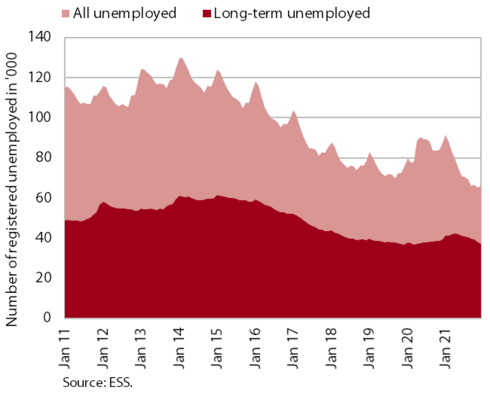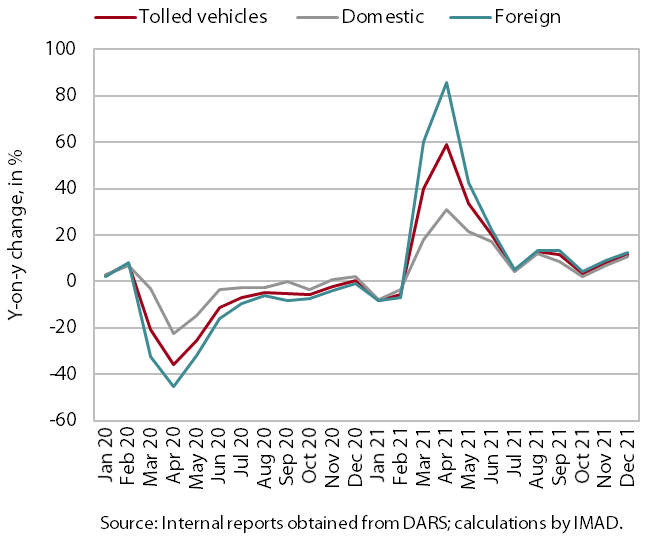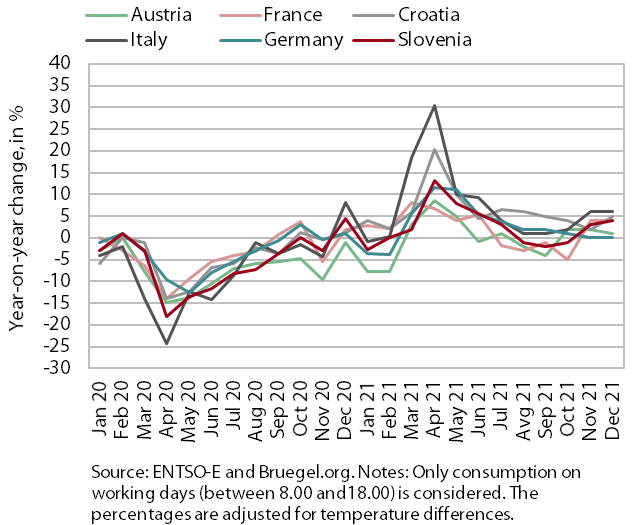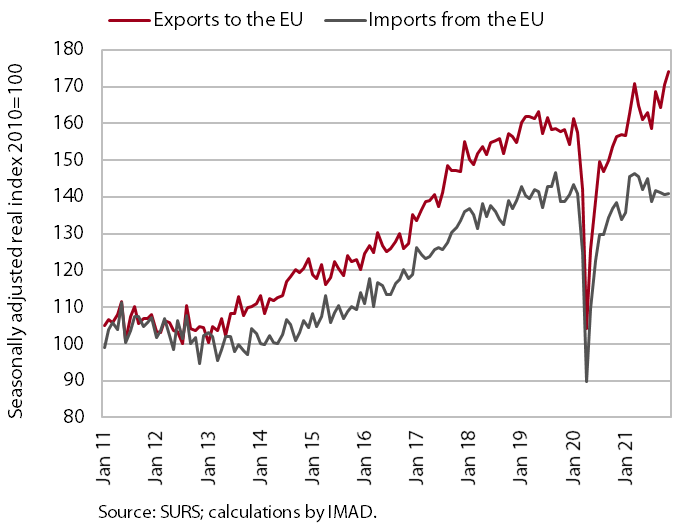Charts of the Week
Current economic trends from 3 to 7 January 2022: registered unemployment, traffic of electronically tolled vehicles on Slovenian motorways, electricity consumption and other
Labour market conditions remain favourable. In December, they were mainly influenced by seasonal developments. At the end of last year, the number of unemployed was significantly lower than in the same periods of 2020 (by 24.4%) and 2019 (by 12.4%). Given the high demand for labour, which is also reflected in the high vacancy rate, the number of long-term unemployed also fell last year, but is still slightly higher than before the epidemic. Electricity consumption was slightly higher in December than in the same periods of 2019 and 2020, and year-on-year growth in freight traffic on Slovenian motorway accelerated, but after adjusting the data for working days, traffic volumes were lower than in December 2019. In the first two months of the last quarter of last year, trade in goods increased in real value (seasonally adjusted) and continued to be significantly higher year-on-year and compared to the same period of 2019. Trade trends continue to be influenced by uncertainties in the international environment and the situation in the European automotive industry, while export expectations of Slovenian companies remain high.
Registered unemployment, December 2021

Seasonally adjusted data show a decrease in the number of registered unemployed decreased in December (by 2.9%), which was more pronounced than in previous months. According to original data, 65,969 people were unemployed at the end of December, 0.9% more than at the end of November. This largely reflects seasonal trends related to a higher inflow into unemployment due to expiration of fixed-term employment contracts. The number of unemployed was 24.4% lower than a year ago and 12.4% lower than in December 2019. Among the unemployed, the number of long-term unemployed rose in the first four months of last year, but then fell slightly again by the end of the year in view of the high demand for labour, which is also reflected in the high rate of job vacancies. At the end of December 2021, there were 5.6% fewer long-term unemployed than at the end of 2020 and 1% more than at the end of 2019. Of the long-term unemployed, more than half have been unemployed for more than two years.
Traffic of electronically tolled vehicles on Slovenian motorways, December 2021

In December, freight traffic volumes on Slovenian motorways increased by 12% year-on-year. The high year-on-year increase is due to the lower traffic volumes in the second wave of the epidemic in 2020 and the fact that December 2021 had one more working day. Freight traffic volumes were also significantly higher than in December 2019, but after adjusting the data for working days (three more working days in 2021), they were about 3% lower. Overall, traffic volumes in 2021 were 14% higher than in 2020 and 1% higher than in 2019 (adjusted for working days). The share of foreign vehicle traffic, which had fallen slightly in 2020, returned more or less to the pre-epidemic level of 60%.
Electricity consumption, December 2021

Electricity consumption in December was about 4% higher than in December 2019 and 2020. The growth in consumption is mainly due to low base in December 2020 related to the strict containment measures and the less favourable timing of holidays in terms of the functioning of the economy in December 2019. Among Slovenia's main trading partners, France (4%), Croatia (5%) and Italy (6%) recorded higher consumption than in December 2020. Consumption in Austria and Germany remained about the same as in December 2020, which was related to the imposition of a new full national lockdown in Austria and the lockdown in some federal states in Germany. Compared to December 2019, consumption was higher by 6% in France and Croatia, by 8% in Italy, by 2% in Germany, while consumption in Austria remained about the same.
Trade in goods, November 2021

Trade in goods continued to increase in November; uncertainty in the international environment has a noticeable effect on the fluctuations in export and import activity in Slovenia. Exports of goods, especially to EU Member States, increased in November for the second month in a row, while imports remained at the level reached (seasonally adjusted). At the same time, there have been stronger monthly fluctuations in trade in goods with other EU Member States (Germany, France, Austria) in recent months, which we believe were mainly related to exports of vehicles and vehicle parts and accessories. Trade in goods, especially trade in automotive industry products, continues to be particularly affected by uncertainties related to supply chain disruptions (especially in the automotive industry) and high commodity prices. In the first eleven months, goods exports to the EU increased by around 13.8% compared to the same period in 2019 and imports from the EU by 11.8%. Export expectations and orders rose further in December, well above long-term averages.
